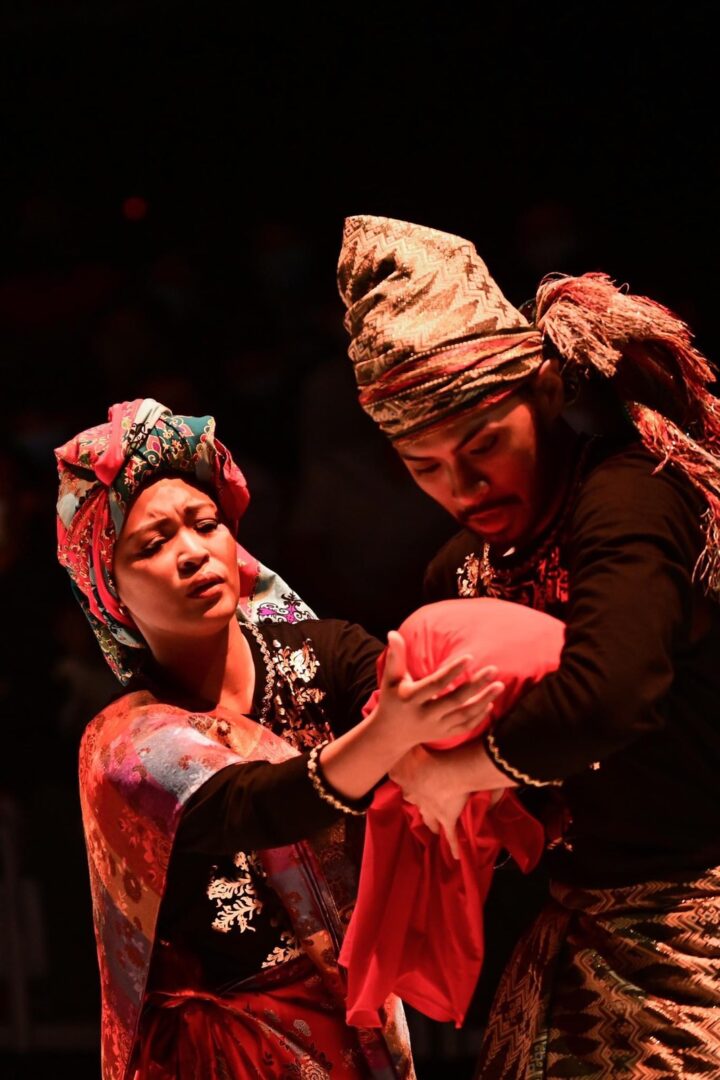Anak Datu, Tanghalang Pilipino’s maiden offering for its 36th season, is a searing statement on national political power.
Written by Rody Vera and directed by Chris Millado, Anak Datu weaves fact and fiction, love and loss, and massacre and myth into a piece of disconcerting theater that dissects the origins of Muslim discontent, the Mindanao conflict, and the friction and confusion within a Muslim-Christian family household.
Vera said his script revolves around three themes: National Artist for Sculpture Abdulmari Imao’s children’s book of the same title; the violent history of Mindanao; and the political awakening of Imao’s son, Toym, who is a fan of the 1970s Japanese anime series Voltes V.
Millado and his assistant directors, Marco Viana (also playing the role of the national artist) and Antonette Go (as the Christian wife of the national artist) ably explore simmering family tensions as a means to echo the larger national conflict, often brutal, between Christian and Muslim Filipinos.
What makes Anak Datu engaging —although one may feel lost and bewildered during certain scenes — are GA Fallarme’s computer-generated projections, the lighting design by Katsch Catoy, and Barbie Tan-Tiongco’s technical direction. (Charlotte Job Despuez joined this team as assistant lighting designer.)
The trio inundates the newly inaugurated Tanghalang Ignacio Gimenez with colors from the artworks of the national artist and his son’s Voltes V collection and redden the space to recall the brutalities of the past and present.
Toym’s perpetually moving props-on-wheels manifest the never-ending shifts in political alliances and power relations in Mindanao, always changing but getting nowhere near any solution to the age-old problems.
Carlo Pagunaling’s deft use of malong and other Muslim costumes exemplify his versatility, notably the children’s “Outfit of the Day look” and the military uniform.
The fusion of talents of TJ Ramos, Chino Toledo, and the gong ensemble, which occupy a special place in the stage design, create music of marked melancholia and sounds of sadness and savagery that heighten the drama, complementing the visual spread projected from floor to ceiling of the new CCP Black Box.
Haunting are the scenes where the names of the victims are projected on the walls.
Choreographer Hassanain Magarang, along with assistant choreographer Lhorvie Nuevo and dance captain Vince Macapobre, should be credited for the actors’ credible dance and fight scenes. Notice the minute movements of their hands and fine flow of their feet.

OF KYLE VENTURILLO
Special mention must be made of Nanding Josef (as Matandang Jibin Arula), Carlos Dala (Binatang Karim/Toym Imao), Earle Figuracion (Jikiran), Tex Ordonez-de Leon (narrator of Putli Loling), Magarang (Datu Karim), Marco Viana (Abdulmari), Lhorvie Nuevo (Putli Loling), Antonette Go (Grace de Leon), and the ensemble for their fine, fierce work in this play.
Nonetheless, when I watched Anak Datu during its first weekend run, I was lost and bewildered at certain points. Many things were happening, but they were not clearly demarcated.
The transformation of characters from “fiction” (Anak Datu, the book) and “present” (Anak Datu, the play) was difficult to follow at times. Perhaps, a more accentuated change in lighting and other elements would help mark the changes in time or locale?
Despite these minor flaws, Anak Datu is an important, must-see production for the integrity it brings in exploring historic Mindanao issues and problems.
Anak Datu’s remaining playdates are on 7 October (8 p.m.), 8 (3 and 8 p.m.), and 9 (3 p.m.) at the CCP Blackbox Theater, CCP Complex, Pasay City.
